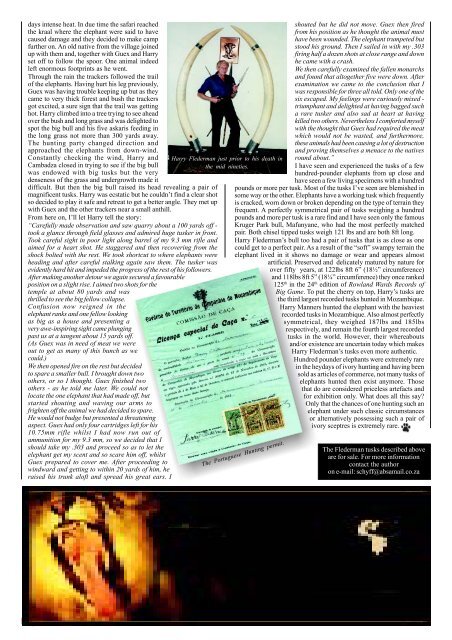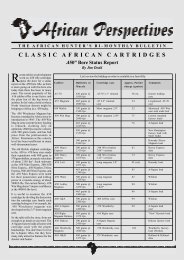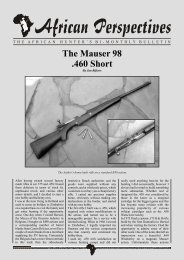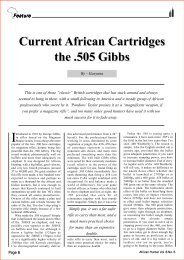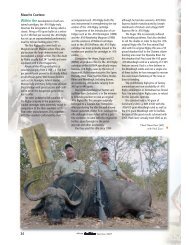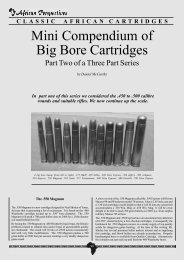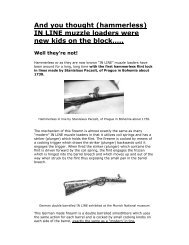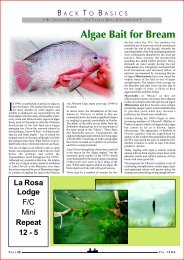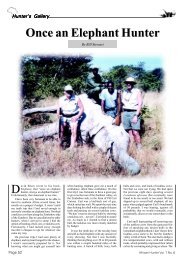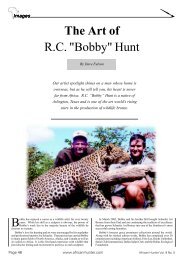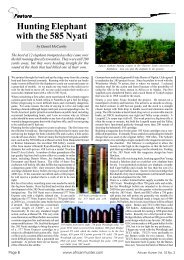Hunter's Gallery - HuntNetwork
Hunter's Gallery - HuntNetwork
Hunter's Gallery - HuntNetwork
You also want an ePaper? Increase the reach of your titles
YUMPU automatically turns print PDFs into web optimized ePapers that Google loves.
days intense heat. In due time the safari reached<br />
the kraal where the elephant were said to have<br />
caused damage and they decided to make camp<br />
further on. An old native from the village joined<br />
up with them and, together with Guex and Harry<br />
set off to follow the spoor. One animal indeed<br />
left enormous footprints as he went.<br />
Through the rain the trackers followed the trail<br />
of the elephants. Having hurt his leg previously,<br />
Guex was having trouble keeping up but as they<br />
came to very thick forest and bush the trackers<br />
got excited, a sure sign that the trail was getting<br />
hot. Harry climbed into a tree trying to see ahead<br />
over the bush and long grass and was delighted to<br />
spot the big bull and his five askaris feeding in<br />
the long grass not more than 300 yards away.<br />
The hunting party changed direction and<br />
approached the elephants from down-wind.<br />
Constantly checking the wind, Harry and<br />
Cambadza closed in trying to see if the big bull<br />
was endowed with big tusks but the very<br />
denseness of the grass and undergrowth made it<br />
difficult. But then the big bull raised its head revealing a pair of<br />
magnificent tusks. Harry was ecstatic but he couldn’t find a clear shot<br />
so decided to play it safe and retreat to get a better angle. They met up<br />
with Guex and the other trackers near a small anthill.<br />
From here on, I’ll let Harry tell the story:<br />
“Carefully made observation and saw quarry about a 100 yards off -<br />
took a glance through field glasses and admired huge tusker in front.<br />
Took careful sight in poor light along barrel of my 9.3 mm rifle and<br />
aimed for a heart shot. He staggered and then recovering from the<br />
shock bolted with the rest. We took shortcut to where elephants were<br />
heading and after careful stalking again saw them. The tusker was<br />
evidently hard hit and impeded the progress of the rest of his followers.<br />
After making another detour we again secured a favourable<br />
position on a slight rise. I aimed two shots for the<br />
temple at about 80 yards and was<br />
thrilled to see the big fellow collapse.<br />
Confusion now reigned in the<br />
elephant ranks and one fellow looking<br />
as big as a house and presenting a<br />
very awe-inspiring sight came plunging<br />
past us at a tangent about 15 yards off.<br />
(As Guex was in need of meat we were<br />
out to get as many of this bunch as we<br />
could.)<br />
We then opened fire on the rest but decided<br />
to spare a smaller bull. I brought down two<br />
others, or so I thought. Guex finished two<br />
others - as he told me later. We could not<br />
locate the one elephant that had made off, but<br />
started shouting and waving our arms to<br />
frighten off the animal we had decided to spare.<br />
He would not budge but presented a threatening<br />
aspect. Guex had only four cartridges left for his<br />
10.75mm rifle whilst I had now run out of<br />
ammunition for my 9.3 mm, so we decided that I<br />
should take my .303 and proceed so as to let the<br />
elephant get my scent and so scare him off, whilst<br />
Guex prepared to cover me. After proceeding to<br />
windward and getting to within 20 yards of him, he<br />
raised his trunk aloft and spread his great ears. I<br />
Harry Flederman just prior to his death in<br />
the mid nineties.<br />
shouted but he did not move. Guex then fired<br />
from his position as he thought the animal must<br />
have been wounded. The elephant trumpeted but<br />
stood his ground. Then I sailed in with my .303<br />
firing half a dozen shots at close range and down<br />
he came with a crash.<br />
We then carefully examined the fallen monarchs<br />
and found that altogether five were down. After<br />
examination we came to the conclusion that I<br />
was responsible for three all told. Only one of the<br />
six escaped. My feelings were curiously mixed -<br />
triumphant and delighted at having bagged such<br />
a rare tusker and also sad at heart at having<br />
killed two others. Nevertheless I comforted myself<br />
with the thought that Guex had required the meat<br />
which would not be wasted, and furthermore,<br />
these animals had been causing a lot of destruction<br />
and proving themselves a menace to the natives<br />
round about.”<br />
I have seen and experienced the tusks of a few<br />
hundred-pounder elephants from up close and<br />
have seen a few living specimens with a hundred<br />
pounds or more per tusk. Most of the tusks I’ve seen are blemished in<br />
some way or the other. Elephants have a working tusk which frequently<br />
is cracked, worn down or broken depending on the type of terrain they<br />
frequent. A perfectly symmetrical pair of tusks weighing a hundred<br />
pounds and more per tusk is a rare find and I have seen only the famous<br />
Kruger Park bull, Mafunyane, who had the most perfectly matched<br />
pair. Both chisel tipped tusks weigh 121 lbs and are both 8ft long.<br />
Harry Flederman’s bull too had a pair of tusks that is as close as one<br />
could get to a perfect pair. As a result of the “soft” swampy terrain the<br />
elephant lived in it shows no damage or wear and appears almost<br />
artificial. Preserved and delicately matured by nature for<br />
over fifty years, at 122lbs 8ft 6” (18½” circumference)<br />
and 118lbs 8ft 5” (18¼” circumference) they once ranked<br />
125 th in the 24 th edition of Rowland Wards Records of<br />
Big Game. To put the cherry on top, Harry’s tusks are<br />
the third largest recorded tusks hunted in Mozambique.<br />
Harry Manners hunted the elephant with the heaviest<br />
recorded tusks in Mozambique. Also almost perfectly<br />
symmetrical, they weighed 187lbs and 185lbs<br />
respectively, and remain the fourth largest recorded<br />
tusks in the world. However, their whereabouts<br />
and/or existence are uncertain today which makes<br />
Harry Flederman’s tusks even more authentic.<br />
Hundred pounder elephants were extremely rare<br />
in the heydays of ivory hunting and having been<br />
sold as articles of commerce, not many tusks of<br />
elephants hunted then exist anymore. Those<br />
that do are considered priceless artefacts and<br />
for exhibition only. What does all this say?<br />
Only that the chances of one hunting such an<br />
elephant under such classic circumstances<br />
or alternatively possessing such a pair of<br />
ivory sceptres is extremely rare.<br />
The Portuguese Hunting permit.<br />
The Flederman tusks described above<br />
are for sale. For more information<br />
contact the author<br />
on e-mail: schyff@absamail.co.za<br />
Page 46 www.african-hunter.com African Hunter Vol. 10 No. 5


